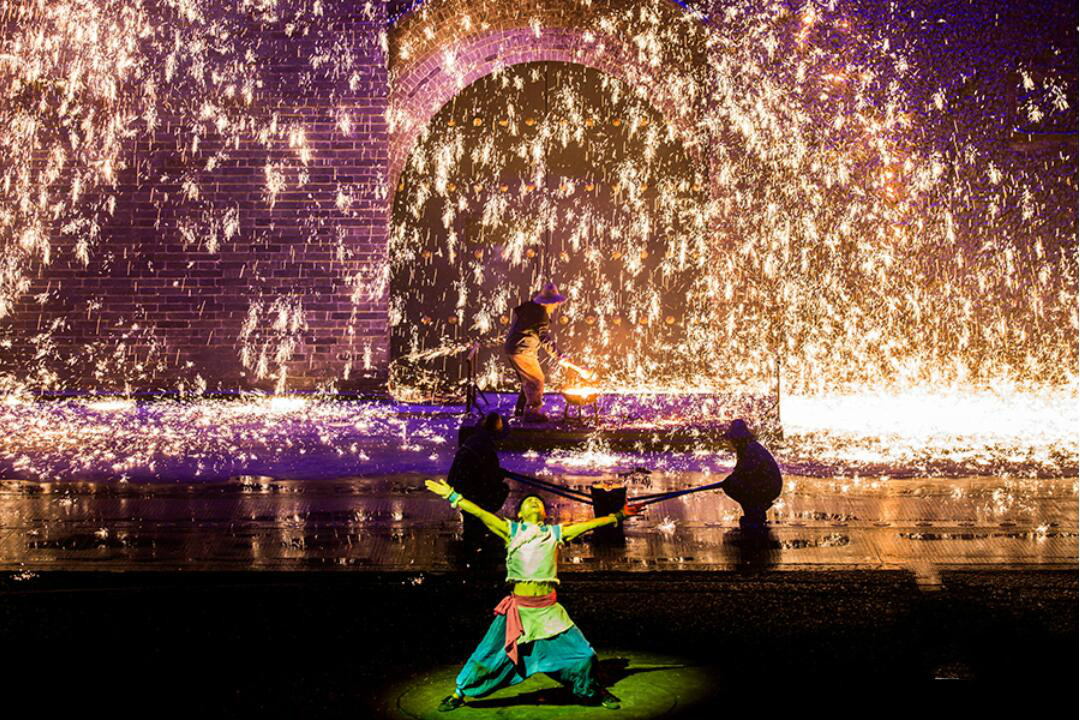Traditional folk art etched in sparks

Modern “dashuhua” artists integrate the elements of musical drama with the traditional molten iron fireworks. They utilize modern technologies, such as sound effects and stage lighting, to perfectly reveal the spectacularity of the “dashuhua” performance.
The tradition of “dashuhua” has been practiced by blacksmiths as a form of entertainment for more than 500 years for the Lantern Festival in Nuanquan Town, Yuxian County, Hebei Province.
This dangerous tradition involves throwing scraps of molten iron toward the bricks of the city gate, which then releases thousands of sparks. This results in a fiery visual spectacle that resembles a tree’s spreading branches, which is as good as setting off fireworks. That’s the reason why it is called “dashuhua,” literally meaning “beating down tree flowers.”
On every Lantern Festival, this dangerous but unique display can be witnessed in Nuanquan Town. An ancient skill, “dashuhua” has become an example of provincial-level intangible cultural heritage.
Scalding molten iron hits the cold city gate and spurts out sparks like waterfalls from the skies. Under the moonlight, myriad stars shine in the sky above the beauty of the sparks on the ground. This was the earliest memory Wang De had in his childhood. At that time, he never thought he would make a living with this skill when he grew up.
When Wang was a child, he looked forward to the “dashuhua” performance most of all during the Spring Festival. He stood in front of the tall city gate and saw blacksmiths melt scrap iron into liquid iron. The blacksmiths scooped up the molten iron with a wet willow wood spoon and rapidly launched it at the city wall. Immediately, thousands of fire sparks burst into blossoms. This ancient performance originated from the Ming Dynasty to celebrate a good harvest and pray for good weather for the crops during the following year.
For hundreds of years, this amazing festival entertainment was popular in Wang’s hometown, Nuanquan Town. Nowadays, “dashuhua” has become a special performance attracting a number of visitors.
Nuanquan Town is located in the west of Yuxian County and is rich in spring water resources. June each year is the peak tourist season. People come here, not only for those well-preserved Ming and Qing examples of architecture, such as theatrical stages, memorial archways and temples in the town, but also for the amazing molten iron performance.
Almost every weekend night, at the Shuhua Square of the town, there is always applause and cheers for “dashuhua” performance. Because wool doesn’t burn when it catches fire, performers wear heavy sheepskin jackets for protection in these summer days, and put straw hats over their heads and fireproof shoe covers on as well.
“The cheers of the audiences are much louder, so I perform much harder,” Wang said.
Wang just treated “dashuhua” as a hobby when he was young, but now he cannot imagine that the molten iron fireworks are warmly welcomed by the audience.
Working in the farmland in the daytime and performing “dashuhua” at night has become Wang’s day to day life. Wang said that many tourists asked him for group photos after his performance. And some Germans shot a documentary based on Wang’s “dashuhua” performance.
However, “dashuhua” is only a game for the brave. It receives not only professional skills but also physical strength and courage.
Wang lifts his sleeves and collar to show both large and small scars scattered across his arms and neck. He rolls up his pants and multiple burn marks can be seen on his legs.
Because of the danger, fewer and fewer young people want to learn this skill, but Wang believes that since the government has focused on protecting cultural heritage, the legacy of “dashuhua” will not die out.
